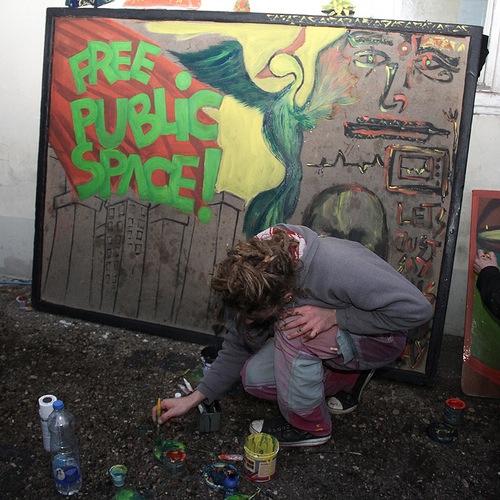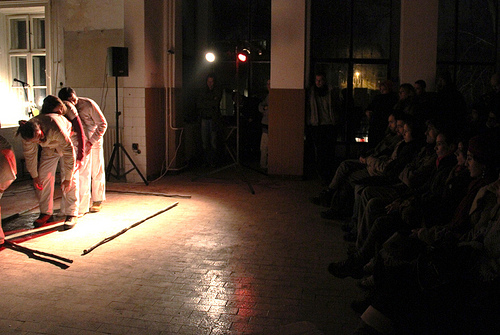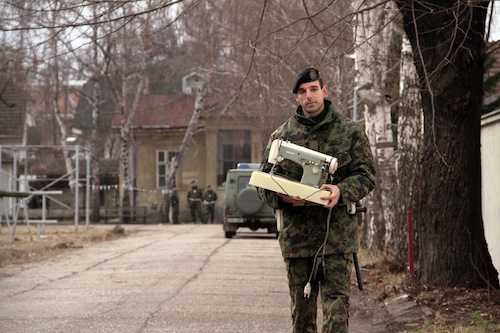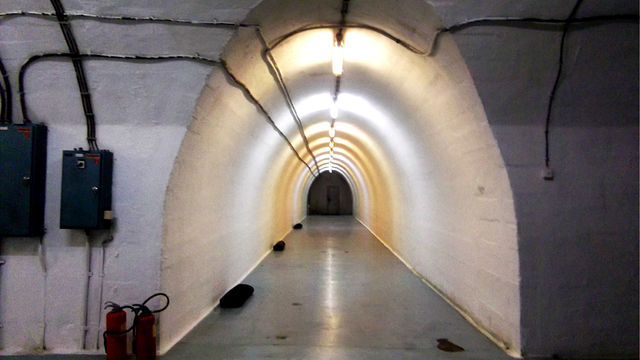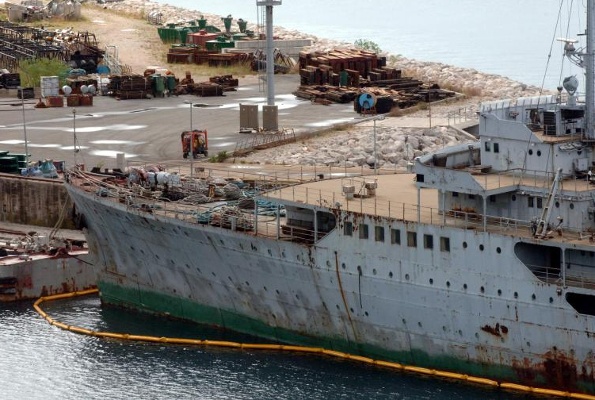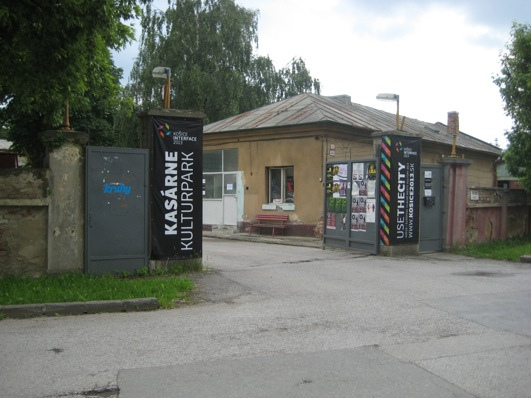[Reposted with permission from the writer, Lily Lynch, see original article here. Thanks Lily!!!]
When former socialist military spaces become new temples of alternative culture, not everyone is happy about it. Whereas in Slovakia the art squatters become institutionalized, in Serbia they get evicted
All across former Yugoslavia, military property owned by the Yugoslav People’s Army (JNA) is being converted into art galleries, cultural centers and autonomous cities within cities. Barracks, battleships and military bases across the region are being demilitarized through squatting and occupations.
The most recent example of this reapprorpriation of military space has been the Drustveni Centar in Novi Sad in Serbia. Last month, a group of over one hundred activists entered the Archibald Reiss kasarna (Serbian for “barracks”) with the plan to create a cultural center in Novi Sad.
The center hosted regional activists, musicians and sewing workshops. Members adopted injured street animals and decorated the neglected barracks with original works of art. There were plans to transform one building into a homeless shelter for street youth. And instead of charging admission fees for events, attendees were asked to donate holiday gifts for children living in local institutions. When I visited the site, one room was filled with over seventy gifts for local children.
Against the stereotypes and assertions plaguing occupiers from Zuccotti Park to the Port of Oakland, the center provided public workshops on how to live drug-free. On the day of my visit, activists were arguing about whether or not to allow alcohol consumption on the premises.
Yet in less than a month, police evicted the group and the center was shut down. The mayor of Novi Sad, Mr. Igor Pavlicic, claims he generally supports the center’s aims, but would prefer that it relocate to an “alternative” setting. According to Srdja Rokvic, one of the center’s activists, the mayor has proposed a new location in Novi Sad’s Chinatown, near the Danube River. But the activists say the site is unacceptable, as it is in extremely poor condition and is inaccessible to persons with physical disabilities.
Since its inception, inclusion of persons with disabilities has been of primary importance for the activists of Drustveni Centar. When the center’s original manifesto was read on the steps at the center’s entrance, it was read both aloud and in sign language. On the day of my visit, persons with disabilities were active participants in discussions on all matters related to the center.
Information about the center has spread throughout both traditional and social media. The group’s Facebook page currently has 3,112 members. While some members of the group are aligned with the Occupy Wall Street movement, others emphasize the need for local, rather than global, engagement. As activist and photographer Danijel Sivinjski stated, “we are completely independent from everybody. We are just trying to create some space for people to connect, produce, educate… we are working for local social, cultural, and artistic life in Novi Sad.”
Tito’s bunker and contemporary art
Despite the hype, the Drustveni Centar is not the first cultural or arts center to begin on the grounds of property formerly operated by the military of the former Yugoslavia.
Buried deep beneath the Bosnian soil and built to withstand nuclear holocaust, Tito’s underground bunker was constructed to shield communist Yugoslavia’s leader and his cronies from deadly radioactive fallout. The cavernous complex so inspired Saddam Hussein in the 1970s that he imported a Yugoslav architect to build a replica in Iraq.
Beginning last year, Tito’s bunker began hosting the Biennale of Contemporary Art, displaying the works of 42 international artists. The massive underground space hosted dozens of sound and video installations inside Tito’s gigantic “Ark”. The Bosnian Ministry of Defense agreed to the Biennale, as their only other plan had been to convert the space into a massive underground mushroom farm.
And like the kasarne in Novi Sad, the JNA barracks at Metelkova in Ljubljana, Slovenia originally began as a squatted cultural center. Following Slovenia’s declaration of independence from Yugoslavia in 1991, the JNA barracks were swiftly abandoned. Metelkova began hosting local and international artists, musicians, DJs and workshops in 1993. It continues to host various cultural events today.
During the summer of last year, an exhibition aboard the famous Yugoslav ship “Galeb” drew some attention from the local media in the coastal town of Rijeka in Croatia. The aim of the show was to exhibit works of art banned by various twentieth century totalitarian regimes. As the organizer of the event Branko Francesci explained: “we realised that the Galeb was perfect. Built in 1938 in fascist leader Benito Mussolini’s Italy, in a totalitarian society that marked the first half of the century, it gained world fame as the ‘sailing office of Marshall Tito’ in another totalitarian regime.”
Kosice, Slovakia: kasarne are the new capital of culture
Despite the Serbian authorities’ official hostility to the idea of the Drustveni Centar, in other parts of Europe, similar initiatives are paying off quite well. The city of Kosice in Slovakia will be designated the European Capital of Culture for 2013 for precisely the same reason the activists in Novi Sad were evicted by the police: Kosice’s former Soviet kasarne have been transformed into a cultural center called Kulturpark, which hosts a diverse monthly program of workshops, lectures, and exhibitions.
Kosice and Novi Sad share other similarities. Like Novi Sad, Kosice is the second largest city of a former communist country; one that famously split into two separate entities at the end of the communist era. And like the capital of Vojvodina, the moderately sized city of Kosice has a well-preserved city center and significant Hungarian and German minority communities.
Kosice’s ability to transform abandoned military barracks into a space for the production and support of new art, music and creative industry was, according to the European Commission, “at the heart” of its choice of the city as the European Capital of Culture for 2013. As Bernd Fesel, owner of the Bureau for Cultural Policy and Cultural Industries and a former advisor to UNESCO stated, “Kosice’s future is hardly conceivable without the revitalization of the former barracks as a public venue and for cultural activities…the European Centre for the Creative Economy thus wants to support Kosice…by contributing experience in using culture as an instrument for transformation.”
“Ok, off you go, you can play that jazz in Kosice.” Serbian artists getting evicted from the barracks in Novi Sad. Photo: Danijel Sivinjski
The European Union’s support for the production of post-Cold War cultural and creative space is compelling. It contrasts dramatically with Serbia’s own continuing insistent militarism. And yet it may conceal something else: the European Union’s own support for and participation in ongoing contemporary conflicts around the world. The vast majority of kasarne in Europe shelter not homeless, disabled and creative youth, but youth bound to fight and possibly die in distant wars.
Still, the demilitarization of abandoned barracks across Yugoslavia undoubtedly represents something important for the region’s transition. As Sivinjski, a Croat living in Serbia, said of his experience of being forcibly removed from the Drustveni Centar by Serbian police, “we were peaceful…we were even dancing and singing.”
